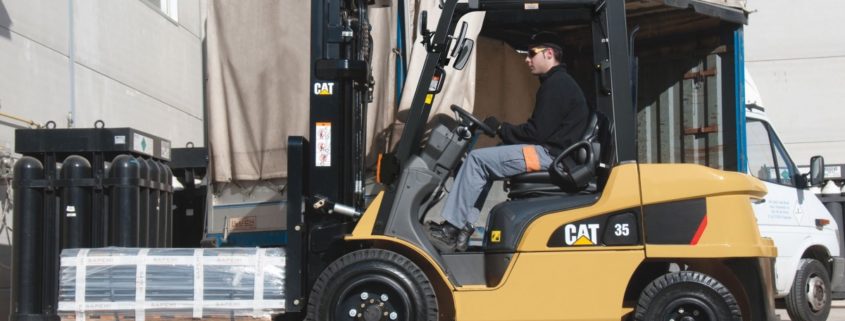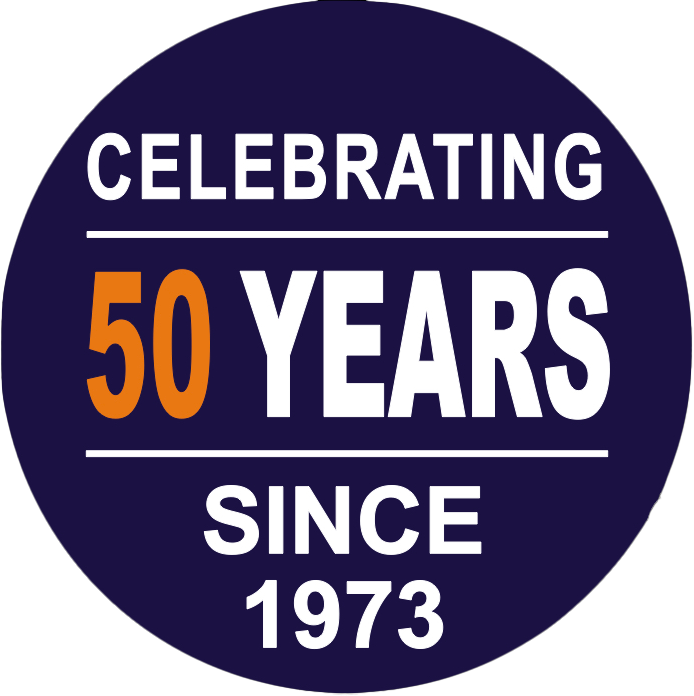Your guide to Warehouse Forklifts
Forklifts are an essential piece of equipment for any warehouse, but they are also one of the most expensive! So, making sure that you choose the right forklift for your warehouse requirements is essential. Depending on the kinds of products you will be handling, the warehouse environment and the type of shelving you have, the most suitable forklift will differ. So, continue reading to discover the most popular and widest used forklifts available and what environments they are most suited for.
1. Counterbalanced forklift
This is one of the most popular and versatile types of forklift. They are used in a wide variety of settings but are mostly used indoors and on flat surfaces. This is the ideal piece of machinery for warehouses, due to its ability to help you move heavy loads across relatively short distances.
Counterbalance forklifts are able to move extremely heavy objects because of the massive weight at the rear of the machine which counterbalances the weight of pallets and materials loaded onto the frontal forks.
Available in electric, diesel or gas models, counterbalanced forklifts are an excellent choice for warehouses with extensive inventories. They are especially handy for loading and unloading pallets and transporting items to/from delivery vehicles.
Some models come in a three-wheel variety, which is helpful if you are short on space, as the four-wheel models can sometimes be challenging to manoeuvre in tight spaces since they have a large turning circle. However, in most situations, this is not a problem, and the benefits of having a powerful, versatile and robust piece of equipment like this vastly outweigh any potential issues with limited manoeuvrability.
2. Sideloader forklift
Sideloader forklifts are not suitable for all your warehouse needs, but they are an absolute blessing in certain situations! If you regularly store long or wide items, then the sideloader is a fantastic choice. They are designed to carry their load sideways, which makes them great for transporting long items such as tubing, sleepers, sheet metal, timber and pipes. The sideloader forklift is also suitable to use in narrow aisles; its unique scissor mechanism of extending forks means that it does not have to turn.
Loading and unloading awkward heavy objects can be a nightmare when using traditional forklifts, but the sideloader makes short work of navigating narrow aisles and handling long products. Sideloaders feature a compartment for the operator and can even be the width of your aisles as they do not need to turn to load or unload.
3. Industrial forklift
Large capacity forklifts or industrial forklifts are capable of shifting heavier loads than the average warehouse forklift. They come in a variety of reach heights and weight capacities but operate similarly to the counterbalance, in that they have a heavyweight at the rear of the machine to counteract heavy loads.
Depending on your requirements, you will be able to get an industrial forklift to suit the needs of your warehouse. It is especially suited to taller shelving systems as they are capable of lifting loads off much higher off the ground than a standard warehouse forklift. However, industrial forklifts are only necessary for a narrow range of situations, as it usually is rare for such power to be needed.
4. Rough terrain forklift
This forklift is absolutely essential if you work in rough outdoor conditions, such as a builder’s merchants, farm, construction site or garden centre. Rough terrain forklifts are capable of working on rough ground such as gravel, rocks, pebbles and uneven earth due to their robust structure. This forklift features durable pneumatic (inflatable) tyres, heavy tyre tread, high ground clearance and a powerful engine. Ideal for outdoor work, these machines are not designed to be used indoors – especially as most are diesel-powered.
If your warehouse is indoors, and the only outdoor transportation required is between shelves and lorries or offloading vehicles, then you would not need to go to the expense of a rough terrain forklift. The only circumstance in which you might consider it is if the path leading to vehicles is rough, although, in this case, it would probably be cheaper to resurface the road or pathway rather than buy or rent a rough terrain forklift.
5. Pallet jack
Pallet jacks are designed to be used in smaller locations, with lower capacities. Also known as pump trucks, they can be operated manually or with an electric battery. Due to their small size, they are perfect in a vast array of settings such as shops, warehouses and stockrooms, where space is at a premium, and you need a forklift to access pallets in the tightest of spaces.
If you need to move floor level items, then this is an essential tool, but bear in mind that this is not suitable for heavier loads or for loading/unloading anything from higher than ground level. It is also only suitable for transporting pallets, and will only be able to lift loads a few inches of the ground.
Pallet jacks are relatively inexpensive, so make a worthwhile investment in most warehouses, even if you only need to use it occasionally. This kind of forklift does not have the power to move quickly, though, which may be an advantage in some settings, especially those tight on space.
6. Telescopic handler
Sometimes known as a telehandler, reach forklift or cherry-picker – the telescopic handler is the ultimate high-reaching forklift. The boom and extendable arm mean that it can be used as either a forklift or a small crane. Ideally suited to construction or agricultural settings, the telescopic handler can also be used in warehouses which require forklifts to load and unload products at extreme heights. The telehandler is also able to manoeuvre pallets and payloads into tight spaces and at odd angles, making this perfect if you want to maximise space.
Available with a range of attachments (aside from lifting forks) they can be helpful in a huge number of circumstances. These powerful machines don’t come without a downside, though – they can be pretty costly! Due to their power and size, they are also less easy to manoeuvre and have a large turning circle. However, their power, durability and strength as well as their suitability for use on rough terrain, makes them an indispensable tool for moving around heavy items into hard to reach places.
7. Walkie Stacker
Similar to a pallet jack in that they do not have a cab for the operator to sit or stand in, a walkie stacker is steered by a worker using a handle attached to the back of the stacker. The main difference between a walkie stacker and a pallet jack is that pallet jack is only suitable for moving things at floor level whereas a walkie stacker is able to reach further up off the ground to load and unload pallets. Like the pallet jack, this product is not particularly powerful or fast, and it also doesn’t have a large counterweight to counteract the weight of the material being transported. For this reason, the walkie stacker should only be used to carry lighter loads.
8. Order picker
An order picker is a type of walkie stacker or reach forklift, but instead of using them to load pallets onto shelves or unloading materials from lorries or trucks, they are used to lift an operator up to the warehouse’s shelves/racks so that they can pick the correct item and bring it down again.
Order pickers are essential for warehouses which ship out individual items, where you do not want or need entire pallets to be brought down to ground level. Normally, reaching heights up to 32ft, an order picker is a versatile and handy tool to have for almost any industry whether you store washing machines or sofas.
Most order pickers are battery-powered and come in a variety of capacities, lift heights and platform sizes. Obviously, if items are quite large, e.g. an armchair, the type of lift you pick will need to have a big enough platform size and power capacity.
9. Pallet Trucks
Palet trucks come in two main types, manual and powered. Similar to pallet jacks, a pallet truck usually has a larger platform size allowing for the transportation of more than one pallet at a time either horizontally or vertically. They operate in much the same way though, by slipping the fork under the pallet and using a hydraulic jack to lift the payload. Manual pallet trucks are hand-operated and powered trucks are motor-powered and more suitable for moving heavier items. Powered pallet trucks are also much more speedy and are ideal for loading and unloading pallets from a truck or other delivery vehicle, for distribution across a large warehouse.
10. High rack stackers
Sometimes warehouses have super tight aisles, and where this is the case, a narrow high rack stack should definitely be considered. Many models of high rack stackers have a large storage capacity and a clear view for the operator, which makes it a safer alternative to many traditional types of forklifts in tight quarters.
The use of specially designed high rack stackers has become more popular in recent years as retailers and manufacturers attempt to maximise space in their warehouses. Forklifts designed to be used in tight spaces, allow for more shelves to be built and more product to be stored. High rack stackers that can operate in narrow spaces are particularly helpful as not only can they work in narrow spaces, they can also reach higher than ordinary forklifts, so space can be maximised both off the ground and on the ground!
High rack stackers are different from traditional reach or telescopic forklifts as they are often designed with advanced technology to be semi-automatic – in some cases, this can even mean that no human operator is necessary. However, the most efficient option (prone to less error) are stackers, which allow for an operator to be lifted up and down with the machine to ensure easy (and correct) pallet retrieval.
Whatever your needs for warehouse forklifts, we’d love to have a chat. Get in touch and talk to our friendly staff today about what you need for your warehouse and how we can help.



